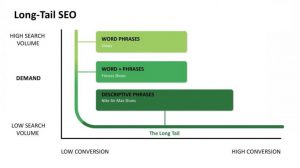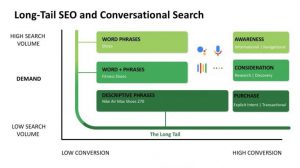Learn the benefits of highly targeted search terms packed with intent. Here’s how to find long-tail keywords and use them to your advantage.
Standalone broad keyword strategies belong to the past. In 2021, the combination of Google’s focus on user experience and intent, alongside the rise of conversational search and applications such as voice search, means that long-tail SEO strategies are more crucial than ever.
Years ago, hunting for long-tail keywords with low search volume might have seemed like a waste of time and effort.
If you don’t have a long-tail SEO strategy, you’re missing out.
It’s never been easier to research long-tail keyword opportunities, target low-competition keywords with high conversion rates, and use long-tail keywords to boost your content.
This guide will show you how to do just that.
What Are Long-Tail Keywords?
 Long-tail keywords are highly targeted search phrases that specifically serve searcher intent. These keywords typically have low search volume, low competition, and high conversion rates.
Long-tail keywords are highly targeted search phrases that specifically serve searcher intent. These keywords typically have low search volume, low competition, and high conversion rates.
We call these keywords long-tail because if you were to plot your keywords by their search volumes, these would be on the “long tail” end of the search demand curve, which means few people are searching for these terms each month.
However, despite the lack of search volume, long-tail keywords are often easier to rank for and result in higher conversions than seed keywords.
This is because long-tail keywords communicate a clear customer need that you can solve — they’re intent-driven.
When you understand search intent, you can create content that specifically addresses queries and converts.
For example, a user searching for [Nike Air Max 270] indicates a clear intent to purchase. Comparatively, a search for [shoes or trainers] is a lot less clear.
The user might be looking for more information about what’s on offer, searching for different brands, or just seeking out of interest.
Note that the actual length of these keywords technically doesn’t matter. Long-tail keywords tend to be at least three words long due to their specificity, but precise low-volume searches that are only one or two words long (such as many brand names) are also considered long-tail keywords.
Why Long-tail Keywords Are Important in SEO
Let’s do a social experiment: log into your Google Search Console account right now and scroll through the search terms. What do you see? I’m willing to bet that most of the terms you rank for are long-tail.
According to Backlinko’s analysis of 306 million keywords, 91.8% of all search queries are long-tail keywords.
Now imagine what you could do if all those highly-targeted queries funneled new leads directly to your high-converting assets.
There are three main benefits to targeting these precise keywords.
1. Less Competition
Long-tail keywords are specific to your business and your niche, and as a result, search volume is low.
The upside of this is that it doesn’t take nearly as much effort to rank well for your targeted long-tail keywords.
Some simple on-page SEO and link building should catapult your landing pages into a place of prominence if your targeted terms are specific enough.
2. Higher Conversions
A little long-tail keyword sleuthing will help you discover search intent.
With search intent, you’ll be able to identify queries that indicate buyer’s intent (e.g., [buy Canada 150 collector’s coins]) and a need for additional information (e.g. [how to target long-tail keywords]).
You can use this knowledge to usher highly qualified leads into your sales funnel and complement your content marketing efforts.
3. It Helps You Optimize for Semantic, Conversational & Voice Search
Long-tail keywords are an integral part of optimizing for semantic search.
We live in an age where 55% of millennials use voice search daily.
When these users query these platforms, they use long-tail keyword phrases such as questions ([what are the best sushi restaurants nearby?]) and commands with clear intent ([compare the price of the dresses from Blush and Sherri Hill]).
Try to predict the intent behind naturally spoken and voice search questions so that you can provide answers about your business and services and better target these long-tail keyword phrases.
Remember, if you target high-converting long-tail keywords even when search density is low, these keywords can still be incredibly valuable for your business.
How to Find Long-Tail Keywords
Ranking for the right long-tail keywords might be better than striking gold.
Discovering new long-tail keywords is easy, and you can create a substantial list in minutes.
First, grab the long-tail keywords that you know you rank from your Search Console.
Now download the same information for your PPC campaigns, Facebook page, Twitter account, YouTube videos, Instagram, and any other metrics you can think of that might reveal new terms.
Next, try to discover new long-tail keywords in your niche that you could rank for. Here’s how to create a list of potential long-tails manually:
Prepare a list of seed keywords. Use a keyword planning tool to generate a list of seed keywords but try to stay away from Google AdWords. While this free tool is excellent for developing a list of commercial terms to target, it intentionally steers away from long-tail terms with lower search volume, making it not very useful for our purposes.
Look at Google’s autocomplete suggestions. Type each seed keyword into Google and write down its autocomplete suggestions.
Collate Google’s related search suggestions. Scroll to the bottom of each SERP and write down the related searches.
Rinse and repeat for Bing Search Suggestions and any other search engines you want to optimize for.
Add these potential long-tails to your target list. Group all your terms and get ready to start pruning your list.
Advancements in SEO technology make this entire research step easy!
- The best programs will even sort through multiple search engines for you, and they may discover long-tails you overlooked. Many other programs intuitively discover and sort through long-tail keywords on your behalf.
- Now that you have a comprehensive list of all of your potential keywords, it’s time to begin pruning your list. Weed out any terms that don’t clearly communicate user intent. For example, in the “long-tail keywords related search results” listed above, the query “short tail keywords” isn’t specific enough.
When you’ve trimmed your list down to the strongest candidates (anywhere from half a dozen to a few hundred long-tails), you’ll be ready to start optimizing your pages and adding them to your content.
How to Build Content Around Long-Tail Keywords
Now that you have a list of long-tail keywords you can optimize for, what do you do with that information? The answer depends on how many long-tails you’re targeting and how closely their topics intersect.
- Conventional wisdom dictates that you need to create a dedicated page per long-tail if you can, great! But this isn’t always feasible.
- When you have hundreds of long-tails to target, you need content other than dedicated landing pages that you can optimize for your long-tails.
- Break down your list of potential long-tail keywords into an easy-to-understand list organized by searcher intent.
Organizing your keywords by topic allows you to find natural places for them to live.
If this content already exists on your site, you might be able to insert these long-tails into your copy naturally. If not, you now have ideas for what your following pieces of content should focus on.
Whenever you publish new content, don’t forget about internal links. These are some of the best places for you to include some of the long-tail terms you so thoroughly researched.
Final Thoughts
Now you know how to discover long-tail keywords and use them to your advantage. But remember: Your long-tail targeting is only as strong as your content.
In 2021, if you aren’t recognized as an authority in your niche, it’s time to start creating high-value assets, blogging about your industry, and rewriting your web copy to communicate your unique value proposition (UVP) to your customers.
While you’re creating your content and optimizing your pages to include your new long-tail keywords, don’t forget to measure your rankings and traffic.
As you do so, you may discover even more keyword phrases you can target, and that will help you continue to build your reputation and improve your on-page SEO.

